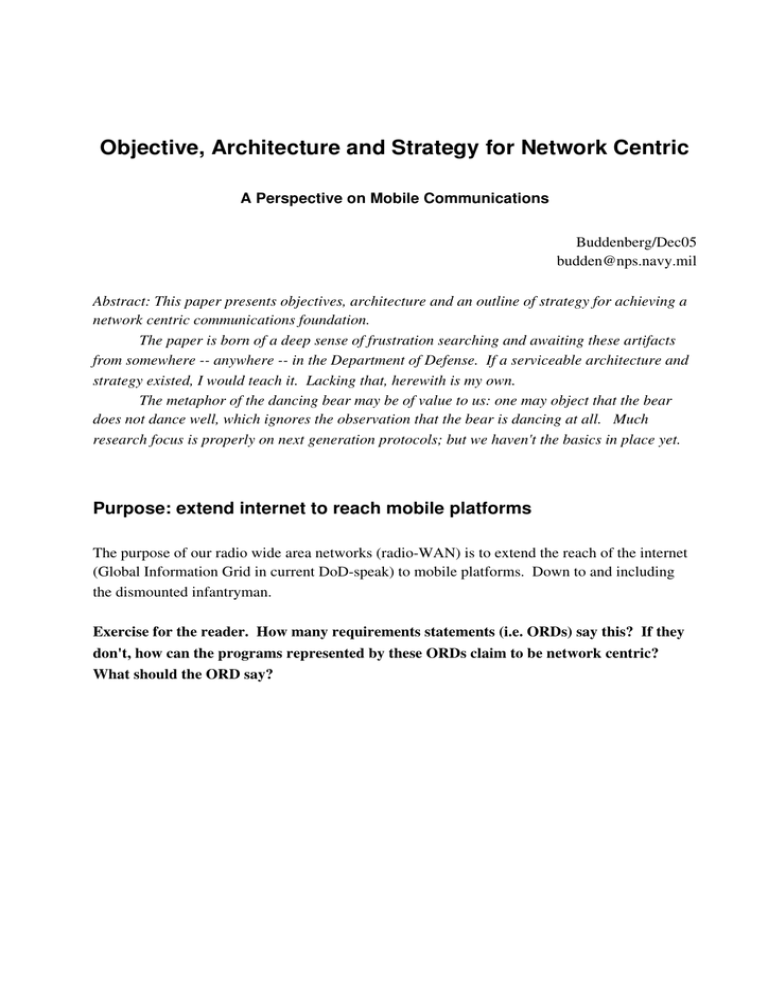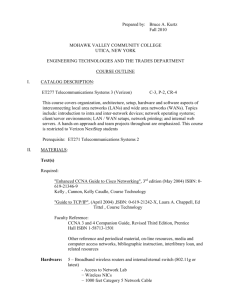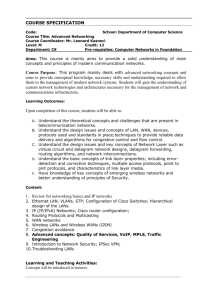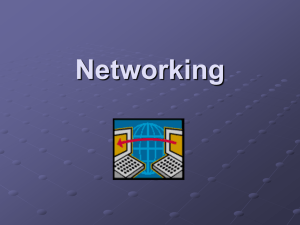Objective, Architecture and Strategy for Network Centric
advertisement

Objective, Architecture and Strategy for Network Centric
A Perspective on Mobile Communications
Buddenberg/Dec05
budden@nps.navy.mil
Abstract: This paper presents objectives, architecture and an outline of strategy for achieving a
network centric communications foundation.
The paper is born of a deep sense of frustration searching and awaiting these artifacts
from somewhere -- anywhere -- in the Department of Defense. If a serviceable architecture and
strategy existed, I would teach it. Lacking that, herewith is my own.
The metaphor of the dancing bear may be of value to us: one may object that the bear
does not dance well, which ignores the observation that the bear is dancing at all. Much
research focus is properly on next generation protocols; but we haven't the basics in place yet.
Purpose: extend internet to reach mobile platforms
The purpose of our radio wide area networks (radio-WAN) is to extend the reach of the internet
(Global Information Grid in current DoD-speak) to mobile platforms. Down to and including
the dismounted infantryman.
Exercise for the reader. How many requirements statements (i.e. ORDs) say this? If they
don't, how can the programs represented by these ORDs claim to be network centric?
What should the ORD say?
Architecture
Before we can formulate a strategy, we need an architecture to build it into. Architecture is
chronically made harder than it needs to be and is a term that is often abused. Architecture:
design, now components fit together.
An architecture for just one program doesn't do us any good. We need an architecture that spans
multiple programs so their sum adds up greater than the parts.
The principles of network centric (architecture). As I teach in class, there are two:
Principle #1. Platform level LANs. All end systems in a platform are connected to the
unit's LAN.
Explanatory comments.
All information systems are made up of sense, decide, and act end nodes (known as end systems
in internet-speak), and the network that connects them together. Complexity is simply these
same elements together with nesting and chaining.
No end systems are connected to each other (e.g. by point-to-point serial links) and no end
systems in a platform are connected to off-board entities – that's what the router on the unit level
LAN is for.
Modularization is the prize; the standards are only the means to the end. Good network
citizenship for these end systems encompasses:
• a LAN interface
• an enveloping definition (MIME or XML are good examples)
• a means for authentication and encrypting data (e.g. S/MIME, XML-sign and -crypt)
• setting of DSCP on exiting datagrams for QoS purposes
• an SNMP agent that affords both local and remote manageability.
Reasonable exceptions. The objective is to place the mission sensors, the mission decision
support systems and the mission actors (weapons) in an inherently interoperable position. If
the platform is, for example, an aircraft, we should note that this category does not necessarily
include the platform's avionics -- the information system necessary to fly the airplane. A
mindless enforcement of the above rules on the avionics package yields no interoperability
benefits and is likely to be inimical to issues such as flight safety. How far these rules penetrate
into the platform's own control systems is a decision properly left to the program manager
acquiring the platform, without interference from outside mandates such as those from a CIO.
Principle #2. WANs. The WAN, both radio and terrestrial, can be viewed as a network
cloud with routers at the border.
Explanatory comments.
Layer 3. By 'surrounded by routers' we are describing a routable network. In terrestrial WANs,
this is usually accomplished by terminating inherently point-to-point (e.g. copper, fiber optic)
connectivity at routers. In radio-WANs, (and LANs) this is best accomplished by using the
IEEE 802.2 Logical Link Control interface definition and treating the shared-media problems at
layer 2.
Layer 2. Within the cloud, radio-WANs must meet some requirements in order to be useful in
military situations:
• radio-WANs must employ a stable media access control (MAC) that does not stall
under overload, affords good bandwidth efficiency, and allows control of QoS.
This requirement leads to use of scheduling algorithms such as the IEEE 802.16
MAC (DAMA controllers in older satellite communications parlance).
•
•
•
ability to multicast. Multicast is defined as ability to transmit data to multiple
destinations for the price of a single transit. Observing that our radio-WANs are
always four orders of magnitude less capacious than the terrestrial WANs and
platform LANs that they route into makes the requirement obvious.
layer 2 (access control) and layer 1 (traffic analysis, low probability of detection,
and jam resistance) requirements must be accommodated.
SNMP agents should be provisioned into all equipment to allow network
operators to 'read the dials' and 'twist the knobs' both locally and remotely
VPNs. Packet encryptors encrypt an IP datagram, encapsulate it inside another IP datagram and
forward it to a matching packet decryptor. HAIPE and TACLANE are examples. They are
properly considered as layer 3 security devices and it is appropriate to adorn the above cloud
with VPN devices colocated with the routers. These devices have two purposes ... and some
limitations:
• the primary purpose of such a device is to protect the infrastucture (the WAN
cloud) from over-the-network attacks.
• the secondary purpose is to 'black' the traffic over the WAN.
Limitation. While the WAN ceases thereby to be a potential source of compromise, this is not
an end-to-end solution so the security exercise cannot be completed here (see the strategy section
below).
Architecture exercise for the reader. The above principles fit the DoD Architecture
Framework definition of SV1 (system view #1). The DOD AF is not inherently network
centric, but these SV1s are. Applying specifics such as platform names, specific mission
requirements and specific end system labels transforms them into Operational Views
(OV1). What DoD should be doing is applying them uniformly to multiple programs. Try
it with your program.
Strategy
A strategy to implement the above principles encompasses, in author's opinion, a handful of
items:
• LANs
• terrestrial WANs
• radio WANs
• end-to-end security measures
• end-to-end management
• next generation protocols
The shape and color of the problems vary from one of these bullets to the next.
LAN. In the case of LANs, there is no new technology required, only implementation per
Principle #1 above. Attention is required to the principles of high availability engineering. The
shape of the problem is programmatic follow-through. This requirement pertains to all platform
managers.
Exercise for the reader: pick a platform, perhaps one you have served aboard. What
would a network centric solution, implementation of Principle #1, look like?
Terrestrial WAN. While few of DoD's programs are network centric (beyond the first briefing
slide), GIG-BE is an exceptional example of a mammal running around amongst the dinosaurs.
It fits Principle #2 cleanly. Furthermore, GIG-BE program has several salutary features: it
concentrated on getting one thing -- the global terrestrial backbone WAN -- right,and didn't
suffer from a lot of diversionary requirements. And it implemented commercial technology
which was entirely suitable for the purpose -- little to no adaptation was required.
Radio-WANs. We need radio-WANs badly to extend the internet to reach our mobile platforms.
But the programs within DoD are currently suppressed by the monopoly position of the Joint
Tactical Radio System.
Exercise for the reader: hold up your favorite communications program to Principle 2.
How would you alter the program to fit?
Here the shape of the problem includes increasing adaptation from standards-based commercial
technology; an option that we did not have a few years ago.
End to end security. The current Type 1 approved security devices include packet encryptors (e.
g. TACLANE, HAIPE) and link encryptors (e.g. KG-84, KIV-7). These are layer 3 and layer 1
devices respectively and have per-enclave and per-link scope respectively. These devices, while
necessary for these purposes, cannot provide end-to-end security. They are focused on
providing security for the infrastructure, not the data. These devices need to be complemented
by Type 1-approved end-to-end security devices (layer 7) which focus on security of the data.
End-to-end security measures are media-independent. The end-to-end security attribute of
authenticity has the side benefit of guaranteeing integrity which is critically important in fusing
data from multiple heterogeneous sources.
End to end management. Many DoD communications systems devote considerable resources to
managing a particular communications network. But we have only begun to manage multiple
networks and we must if we intend to reach our mobile platforms since data must necessarily
cross multiple networks to reach them. ('Management' is an overloaded term with multiple
definitions -- here I'm using it as synonymous with the traditional Radioman term of 'tech
control' and in the context of network operations). We need not paralyze our progress by
analysis; if each program faithfully provisions SNMP agents in equipment, we have the tools.
The single most important ingredient in the next step that makes up end-to-end management is
our network operators -- people. We need to properly define the skillsets and provide the
training.
Next generation protocols. There is a variety of next generation protocols beyond the current
IPv4, TCP, OSPF and BGP that hold promise. Among those applicable to the military are IPv6,
NORM (Nak-Only Reliable Multicast), and MANET (for which there are several alternative
possible solutions).
None of these next-gen protocols are essential to make the bear dance. They are all good
for improving ursine footwork.
We should observe that all the next generation protocols are implemented in software in
routers and in operating system protocol stacks in end systems. If the routers and end systems
pre-exist, and the routers already run OSPF and/or BGP, they are usually fairly easily upgraded
in situ with new releases of the internet protocols. Therefore lack of an agreed-upon
implementation of next generation protocols should not inhibit development and deployment of
the rest of the infrastructure -- not an excuse for paralysis.
How do we get to a network centric destination?
Therefore it appears that the principal attention belongs to the first five items in the
strategy above. Translate the strategy into programs ... many of which are properly
modifications of existing programs.






